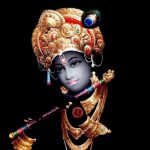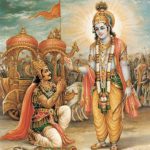Excerpts from a lecture delivered by Sri Srimad Bhaktivedanta Trivikrama Gosvami Maharaja on 17th July 1988 at Sri Uddharana Gaudiya Matha, Chunchura
sa jiyat krsna-caitanyah
sri-rathagre nanarta yah
yenasij jagatam citram
jagannatho ’pi vismitah
sri-rathagre nanarta yah
yenasij jagatam citram
jagannatho ’pi vismitah
All glories to Sri Krsna Caitanya, who danced in front of the chariot of Sri Jagannatha. Seeing Him dance, not only was the whole universe astonished, but Lord Jagannatha Himself became amazed. (Sri Caitanya-caritamrta, Madhya-lila 13.1)
Sri Caitanya Mahaprabhu’s dance in front of Lord Jagannatha’s chariot was so ecstatic it astonished all who saw it. What was the nature of that dance? This is described in Sri Caitanya-caritamrta, Madhya-lila, Chapter Thirteen.
Sri Caitanya Mahaprabhu’s dance in front of Lord Jagannatha’s chariot was so ecstatic it astonished all who saw it. What was the nature of that dance? This is described in Sri Caitanya-caritamrta, Madhya-lila, Chapter Thirteen.
Our attempt to fathom the essential quality of His dance is based on our experience of worldly dances – Indian dance, Manipuri dance, South Indian dance, Russian ballet and so forth. These dances are astounding to behold. The dancers’ movements are so swift and dexterous that they appear to have no bones! They can manipulate their bodies as they please.
Mahaprabhu’s dance excelled these dances by far, and the mood of His dance astonished the entire world. We imagine His dance to resemble these worldly dances, but the subject of it bears no such similarity. Also, the dancing of females is generally considered more attractive than that of males, but Mahaprabhu is male. What was the amazing feature of His dance?
What Was the Subject of His Dance?
Most people think that Mahaprabhu’s devotees exaggerate and overly praise the extraordinary nature of His dance. Srila Kaviraja Gosvami describes how Mahaprabhu’s dance around Lord Jagannatha’s chariot resembled a single firebrand that is rotated so swiftly it appears to be a circle of fire. Mahaprabhu moved with such speed, that He appeared to be simultaneously present at every point of His circumambulation.
Such a sight is certainly astonishing, but our amazement should not stop there. What bhava was manifesting in Sriman Mahaprabhu at a given moment, and what internal transformations was He undergoing as a result? This was the foundation of His dance. Ordinary conditioned souls have a superficial conception of His moods. Only when we become bhavuka, that is, when we deeply understand these moods, will we be able to understand His internal moods and how they stimulated His dance.
We perceive His dance to resemble people’s joyful dancing at a festival. We may even think it is like the dancing of boys and girls in modern times, the sight of which pollutes the mind and stimulates lusty desires. Sriman Mahaprabhu’s dance at Ratha-yatra is not to be compared to the dancing of persons in this material world, because the subject of His dance is not lust, but transcendental love.
Lust and Love
In this world everything is composed of lust. What is lust?
atmendriya-priti-vancha – tare bali ‘kama’
krsnendriya-priti-iccha dhare ‘prema’ nama
krsnendriya-priti-iccha dhare ‘prema’ nama
The desire to gratify one’s own senses is called kama (lust), but the desire to satisfy the senses of Sri Krsna is known as prema (transcendental love). (Sri Caitanya-caritamrta, Adi-lila 4.165)
Sastra thus reveals the true conceptions of lust and love. Any endeavour conditioned souls like us make to indulge the senses – the eyes, ears, nose, tongue and skin – is lust. We think that we will be happy by seeing beautiful objects, smelling fragrant scents, tasting delicious foodstuffs or hearing pleasant sounds, such as a piano, or especially, a lady’s sweet voice. All of our activities aim to satisfy our senses and we consider it good for us. But it is merely lust.
Sastra thus reveals the true conceptions of lust and love. Any endeavour conditioned souls like us make to indulge the senses – the eyes, ears, nose, tongue and skin – is lust. We think that we will be happy by seeing beautiful objects, smelling fragrant scents, tasting delicious foodstuffs or hearing pleasant sounds, such as a piano, or especially, a lady’s sweet voice. All of our activities aim to satisfy our senses and we consider it good for us. But it is merely lust.
In this world we speak of marital love or brotherly love, but neither is true love because the sole purpose of such ‘love’ is to satiate our own senses. Why does a husband love his wife? Because through her, he can gratify his senses. In the same way, a wife satisfies her senses through her husband. Their mutual act of sense gratification cannot be called love.
Atmendriya-priti-vancha – tare bali ‘kama’. It is all lust. Patriotism is also lust. Why do we love our country? We think, “I was born in this country, and its trees, environment, rivers, mountains and so forth delight my mind and body.” Our love is based on our own pleasure. We love everything that delights our senses and gives pleasure to our mind.
What, then, is love? What is the love between Bhagavan and the gopis or between other devotees and their beloved Lord? “Krsnendriya-priti-iccha dhare ‘prema’ nama – the desire to give pleasure to Krsna’s senses is called love.” Acts of sacrifice in brotherly or marital love are not meant for the Lord’s pleasure and are therefore classified as lust. Only acts for the Lord’s pleasure can really be called love.
Faultless Lust
We see that the behaviour of Krsna and the gopis resembles the behaviour of men and women in this world. Krsna became happy by enjoying the gopis through His senses, and the gopis’ senses were also gratified, so how is it love? Atmendriya-priti-vancha tare bali ‘kama’. Why isn’t it called lust?
The gopis are never motivated by a desire to enjoy their own senses; their only desire is to give pleasure to Krsna’s senses. Now, you may argue that since Krsna enjoyed with them, isn’t it lust? But the fact is that Krsna is such an Entity that His lust is love. Our lust certainly is not.
Krsna’s lust is faultless. The type of auspiciousness He can bestow upon one whose service He has enjoyed is incomparable. We cannot bestow that kind of favour upon anyone we enjoy. What kind of auspiciousness can a husband bestow upon his wife by enjoying her? But what can Krsna not do for one whose slightest service He has accepted? Putana, for example, applied poison to her breast and went out to kill Him. She shrewdly displayed maternal affection, saying, “O Baba, O my darling boy, come, have some breast milk.” Although her ‘affection’ was full of duplicity, Krsna reciprocated and gave her the position of a mother in Vaikuntha.
Is this possible for us? Any of us? We can’t liberate even ourselves from this material world, what to speak of liberating someone else from it and granting them the happiness of service in Vaikuntha. If Krsna can liberate a deceitful person like Putana from this material world and instate her as “mother” in Vaikuntha, what will He not give to His dearest beloveds? They truly serve Him with senses that give Him more pleasure than the pleasure He receives from being fed breast milk. What will they not achieve?
Unmotivated Service Yields the Highest Reward
It is for this reason that Krsna said to the gopis, “I will never be able to repay My debt to you.” The gopis’ desire to please Krsna was unconditional. They did not want repayment; furthermore, He was unable to give any. In Srimad Bhagavad-gita (4.11) He promised, “ye yatha mam prapadyante, tams tathaiva bhajamy aham – O Partha! In whichever way a person renders service to Me, I in turn serve him in that very same way.”
Krsna says, “I always repay those who serve Me; I never live in debt.” But to the gopis He said, “na paraye ’ham niravadya – I’ll never be able to repay you. I’ll always remain indebted to you.” (Srimad-Bhagavatam 10.32.22). Why did Krsna say this? “Since you always desire My happiness without a trace of desire for your own, what could I possibly give you that would make you happy?”
The gopis replied, “Our pleasure will come from Your happiness.”
Sri Caitanya-caritamrta (Antya-lila 20.52) quotes Srimati Radhika: “Na gani apana-duhkha, sabe vanchi tanra sukha, tanra sukha – amara tatparya – I do not consider My personal distress; I only desire to make Krsna joyful. Indeed, giving Him delight is the very purpose of My life.” The gopis know nothing other than desiring Krsna’s happiness. This is the purpose of their every action. They even dress with Krsna’s pleasure in mind.
We feel pleased when we dress and decorate ourselves nicely. The gopis also like to look attractive. They don necklaces and other beautiful ornaments, decorate their hair and apply makeup. It may seem that their happiness is derived from beautifying themselves, but this is not the case. The gopis know that upon seeing them, Krsna will feel happy at heart, and for that reason alone they adorn themselves. They don’t aspire for their own pleasure. The little they eat is simply to maintain their charm for Krsna’s pleasure. Their entire range of activities is solely to give pleasure to Sri Krsna. This full dedication to His pleasure is the nature of His devotees.
Externally there may be similarities between the activities of a devotee and those of a non-devotee, but internally they are at opposite poles. Devotees do not desire their own sense gratification; everything they do is for Krsna’s happiness. That is why sastra states that harming a devotee warrants an unlimitedly greater reaction than harming any other living being.
The Pastime that Astonished the Universe
No one has ever relished Ratha-yatra like Sriman Mahaprabhu did. No one else can. His dancing before the chariot astonished not only the entire universe, but Lord Jagannatha Himself. Not only humans, but the moveable and immoveable living beings throughout the universe – the trees, plants, animals, birds and insects – were all astonished. Jagat means that the entire universe was included. How could this be?
We consider these descriptions to be exaggerated or that someone has simply made them up. But the writers of these narrations are not the type of people to deceive us for their own profit, adoration or fame. They are seers of the Truth and they reveal the Truth for our welfare. The writer of this pastime became astonished to behold Mahaprabhu’s incredible dance, and for this reason he explains it with much joy. He directly perceived the universe becoming astonished.
How could all beings understand the greatness of His dance? Why isn’t it said that only those who directly witnessed His dance became astonished? Rather it says “yenasij jagatam citram – the entire universe was astonished.” What is the meaning of jagad here? The soul exists inside every living entity, whether the body encasing it is human or insect. The quality of the soul is the same in all bodies; no soul is greater or lesser than another. The bodies and minds of the various living entities may differ in quality – the human body and mind are certainly superior to the bodies and minds of other living beings – but there is no difference in the quality of their souls. All are the same.
Mahaprabhu demonstrated this when He journeyed through the Jharikhanda jungle. At that time wild creatures, such as elephants, tigers, birds and boars, shed tears of love, and trees and creepers oozed honey out of love. The enmity between the animals dissipated because they were chanting the holy name, and all danced and embraced each other. Prema overwhelms Sriman Mahaprabhu, the personification of prema, and so naturally, it overwhelms all living entities.
Mahaprabhu melted even stones with His love. He went to Alalanatha and displayed such love that the stone melted. He leaned on the wall of the Jagannatha temple in Puri with His hand, and the wall melted. Impressions of His fingers still remain. It is no exaggeration, no fabrication. We cannot melt stone, but does that mean the Lord cannot? He is the master of unlimited universes. His pastimes are astonishing, and He mercifully performs such pastimes to attract us to Him. Srimad-Bhagavatam (1.7.10) states, “ittham-bhuta-guno harih – Sri Hari possesses all transcendental qualities and can attract all beings, including liberated souls.”
We are absorbed in various objects and entities, but do their qualities have this potency? Mahaprabhu Himself revealed His qualities to attract and then benefit us. His appearance alone benefited all the living beings of His time. And the magnanimous conception He instigated – as revealed in the verse anarpita-carim cirat – has continued to this day. We are also trying to imbibe this conception.
What if He had not appeared? We should try to realise the greatness of His compassion. Previously, our wife, children, family, house and so forth were our all in all. What kind of happiness do such attachments bring? Although we constantly bear witness to the misery of the world, we consider it the best possible place for us, being bewildered by powerful illusion. We believe in Bhagavan and chant His names, but we hanker to receive material benedictions from Him.
Ideally, we should deem this world and the objects of enjoyment in it to be most insignificant, yet we cannot relinquish our search for happiness here. We find ourselves becoming increasingly allured by this world instead of becoming attracted to the Lord’s qualities and glories. Such is our misfortune. Yet in His time, Mahaprabhu, the prema-surya, or brilliant sun of pure love, mercifully attracted all the inhabitants of the universe and satiated them with His rays. Deer walked in the jungle uttering the holy name “Krsna, Krsna”. The tiger, wild boar, elephant, snake, peacock, bird – everyone uttered this name. Honey flowed from the trees and creepers due to love, exactly as it flowed from the trees and plants during Sri Krsna’s pastimes in Vraja. Sriman Mahaprabhu is Himself that same tattva, Krsna, and therefore, with the manifestation of that very same prema, identical circumstances occurred.
What is the Real Glory of His Dance?
Essentially, we think that it was the fascinating, external aspect of Sriman Mahaprabhu’s dance that captivated the entire world. But what was the spirit, or life, of that dance? This is what attracted the whole world. As Mahaprabhu danced, what mood absorbed and overwhelmed Him?
Are the artistic movements of a cinema artist or professional dancer inferior to Mahaprabhu’s dance? Russian dance and other dances can amaze us. How attractive these dances are, lifting their legs so high and spinning around! They dance as if their bodies have no bones, and so we compare their dance to Mahaprabhu’s. Has Mahaprabhu showed a greater skill than this? We cannot imagine anything more wonderful. “Oh! Mahaprabhu’s dance is like these dances.” Like what? He is spinning so fast, like a firebrand tied to a swiftly rotating rope, thus appearing to be a single circle of fire. We can understand that this is certainly an incredible feature of His dance.
Now, is Sriman Mahaprabhu’s ability to dance like this a small matter? How can someone spin as fast as a quickly turning wheel where the individual spokes are not discernible? This is our conception of the glory of His dance. What, however, is its real glory that attracted the entire universe?
The soul within all living entities is qualitatively equal. Mahaprabhu’s merciful potency is such that it cleanses the dust from the hearts of all souls, regardless of their body, or external covering. In this way, the function of the soul in the tiger, bear and all others in the Jharikhanda forest was awakened. Trees oozed honey. All became astounded and danced in prema, forgetting all enmity. The entire universe became overwhelmed by the love of Mahaprabhu.
In the same way Mahaprabhu’s flood of love came to Puri Ratha-yatra and as a result, each soul attained his constitutional perfection. Not only the universe became overwhelmed by His prema, but Lord Jagannatha, the supreme, complete Soul, was also overwhelmed by it as He sat on His chariot. We are partial, atomic spirit, and therefore it is not surprising that the glorious pastimes of the Absolute Spirit astound us. But Lord Jagannatha Himself is that Supreme Spirit! How can He be amazed? Maybe that is also an exaggeration. But it is not.
In tattva, both Mahaprabhu and Jagannatha are the same Absolute Truth. Here, it is appropriate to refer to Krsna as Jagannatha because Jagannatha is Dvarakadhisa, the King of Dvaraka city. He who manifests His aisvarya-prema (love in a mood of awe and reverence) to Rukmini, Satyabhama and His other queens is Jagannatha. The Krsna of Vraja never leaves Vraja. He doesn’t even go to Puri or Mayapura. If anyone goes to those places it is Mahaprabhu, who is “radha-bhava-dyuti-suvalitam – that same Krsna replete with the loving moods of Srimati Radharani” (Sri Caitanya-caritamrta, Adi-lila 1.5).
Therefore, when Jagannatha-deva saw Krsna as Mahaprabhu in this dancing pastime, He was astonished and overwhelmed with krsna-prema. This account of Mahaprabhu’s dance is unquestionably an accurate description of what took place and is devoid of a drop of exaggeration.
We Can Never Dance Like Him
We wonder how Jagannatha sitting on His chariot can be bewildered, and think that we also can charm Him in this way. We then dance and circumambulate the chariot of Lord Jagannatha, thus imitating Mahaprabhu. Will we ever be qualified to even come close to the mood of Mahaprabhu in any lifetime?
Gauracandra is radha-bhava-dyuti-suvalitam – Krsnacandra adorned with the bodily lustre of Srimati Radharani and overwhelmed by Her mood. Only He can amaze Jagannatha like this. We are unable to even approach the path leading to Mahaprabhu’s mood. Even if we pass through anartha-nivrtti, in which we become free from desires that hinder our progress in bhakti, and attain liberation or even bhava, we will always remain a partial atomic spirit. We will never be equal to the whole. We may attain the pinnacle of perfection possible for an atomic soul, but we will never be able to dance like Him.
The Sweetness of the Dance of the all Glorious Lord
How unique was the mercy of Mahaprabhu! He blessed the entire world by bestowing nama-sankirtana, the greatest gift from Goloka. He demonstrated the highest service to Krsna imbued to the fullest extent with Srimati Radharani’s absorption in deep feelings of separation from Him. Mahaprabhu’s dance at Ratha-yatra was in this mood. Do we actually even care to know about the bhava He was experiencing? Even if we were to personally witness Mahaprabhu’s dance, we would not understand the first thing about it without receiving His blessings. We would simply observe its external features and wonder, “Oh, what special dance is this?”
Those who are rasika, whom Mahaprabhu has blessed with certain conceptions and emotions, can relish the sweetness of this dancing pastime and of Jagannatha-deva relishing it. Just see how this one sloka describes the pastime in full. How wonderful! How scholarly!
Sa jiyat means, “All glories to Him, all glories to Him!” Simply chanting this, however, does not mean that we can actually glorify Him. But what else shall we say to Him? When we become endowed with a service attitude toward Him, what else can we desire but to sing His glories? We may or may not be successful in spreading them, but at least we desire to. We always desire the victory and welfare of the one we love. Mahaprabhu is always glorious and should be glorified. Our propensity to glorify Him should increase.
“Jagannatho ’pi vismitah – Lord Jagannatha Himself became astonished.” The chariot stopped moving. It was stuck and Lord Jagannatha watched the dance in amazement. Where else will He find a Krsna such as this, who is overwhelmed by the mood of Srimati Radharani? Just see the condition of this Krsna!
jaya jaya sri-krsna-caitanya nityananda
jayadvaita-candra jaya gaura-bhakta-vrnda
jaya srota-gana, suna, kari’ eka mana
ratha-yatraya nrtya prabhura parama mohana
jayadvaita-candra jaya gaura-bhakta-vrnda
jaya srota-gana, suna, kari’ eka mana
ratha-yatraya nrtya prabhura parama mohana
All glories to Sri Krsna Caitanya and Prabhu Nityananda! All glories to Advaita-candra! And all glories to the devotees of Sri Caitanya Mahaprabhu! All glories to the listeners of Sri Caitanya-caritamrta! Please now give your one-pointed attention to hearing the narration of the Ratha-yatra festival in which Sri Caitanya Mahaprabhu danced enchantingly. (Sri Caitanya-caritamrta, Madhya-lila 13.2–3)
We Alone Remain Unmoved by His Dance
It is the proclivity of the body and mind to be attracted to worldly dances because we are still in the bodily conception of life. We wonder what is so unique about Mahaprabhu’s dance because the constitutional function of our soul has not been awakened.
atmaramas ca munayo nirgrantha apy urukrame
kurvanty ahaitukim bhaktim ittham-bhuta-guno harih
kurvanty ahaitukim bhaktim ittham-bhuta-guno harih
All variety of those who are atmarama, who take pleasure in their atma, as well as munis, who are absorbed in contemplating the self, are free from anger, false ego and other anarthas. Still they render selfless, unmotivated loving service, or bhakti, to Sri Hari who performs awesome activities. He possesses such wonderful qualities that He can attract everyone, even those who are already liberated. (Srimad-Bhagavatam 1.7.10)
Such are the qualities of Sri Hari. Even those who fully identify with their atma, not with their bodies and minds, become attracted by the qualities of Sri Hari. Nirgrantha refers to those who have no need or attraction for worldly objects. They are not bound in attachment to their mind and body, or to what is related to their body, such as their father, mother, children, wife, brother, sister, house, property and so forth. Even those who have attained the last limit of liberation are always eager to serve Krsna, just as we are extremely eager to serve our wives and children. Although we should unconditionally endeavour for His happiness and pleasure, our performance of bhakti is filled with prayers like, “O Lord, please grant me health”, “Keep my son well” or “Award me with wealth”.
Such are the qualities of Sri Hari. Even those who fully identify with their atma, not with their bodies and minds, become attracted by the qualities of Sri Hari. Nirgrantha refers to those who have no need or attraction for worldly objects. They are not bound in attachment to their mind and body, or to what is related to their body, such as their father, mother, children, wife, brother, sister, house, property and so forth. Even those who have attained the last limit of liberation are always eager to serve Krsna, just as we are extremely eager to serve our wives and children. Although we should unconditionally endeavour for His happiness and pleasure, our performance of bhakti is filled with prayers like, “O Lord, please grant me health”, “Keep my son well” or “Award me with wealth”.
In how many ways do we try to serve our family members! This needs no explanation. We think ourselves highly blessed to be able to serve them, to supply our wife with cloth, jewellery or any of her favorite items. But the soul has no connection with persons and objects of this world. Sages, therefore, are not inclined to develop such relationships.
Kurvanty ahaitukim bhaktim means “they love”. Bhakti means “to love purely”, and it is a higher stage than liberation. The sages are established in the eternal occupation of the soul, and therefore their abhimana, or identification, is with their atma. Even personalities on this platform love Sri Hari.
The sages’ love comes from the natural propensity of the soul. For those who are conditioned, love is expressed through the body and mind. A magnet’s intrinsic quality is to attract iron; and iron’s inherent quality is to be attracted to a magnet. If another element comes between them, their natural mutual attraction does not manifest until the obstruction is removed.
Similarly, the soul is naturally attracted and related to the Supersoul. The covering of material energy over the soul is the foreign element that blocks the soul’s innate attraction. By eliminating this obstruction, the atomic conscious soul will become fully attracted to the complete conscious Supersoul. That is why this verse emphasises such personalities who, although self-satisfied, are attracted to that Supreme Soul through the natural serving propensity of their atma.
Why do such self-satisfied persons perform bhakti without any material cause? Why does the magnet attract and the iron become attracted? It is their propensity, their nature. In the same way, the constitutional occupation of each and every soul is to engage in bhakti to Bhagavan. Srimad-Bhagavatam (1.2.6) states “sa vai pumsam paro dharmo yato bhaktir adhoksaje – to love, to perform uninterrupted and causeless bhakti to Sri Hari, is the natural tendency of us all.” Such is the relationship between the soul and the Supersoul.
The four Kumaras (Sanaka, Sananda, Sanatana and Sanat-kumara) were liberated souls who also became devotees after smelling the fragrance of the tulasi leaves offered at the lotus feet of the Lord. Although they were liberated, they were not yet acting according to the natural propensity of the soul. Sri Hari’s unique quality is that He can attract such persons and make them His devotees.
Sri Hari can attract all, but He is unable to attract us, despite His substantial endeavour to do so. This is our incalculable misfortune. The dance of Mahaprabhu charmed the whole universe, but we remain unmoved. We reason, “It would be senseless to leave our present situation. He will never successfully attract us, no matter what trickery He employs. We are fine just as we are.”
Transcribed and Edited by the Rays of the Harmonist team
Originally Published in Rays of The Harmonist Number 16, Karttika 2006
Originally Published in Rays of The Harmonist Number 16, Karttika 2006






